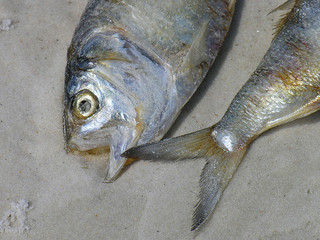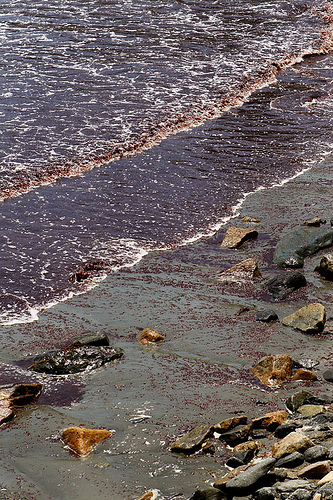
Interactions
In the marine environment
Gonyaulax catenella plays some very large roles. They
are responsible for the majority of photosynthetic carbon
fixation in the ocean. They also make up the base of the food
chain. This dinoflagellate prefers salinity levels between 26-32
and temperatures ranging from 17- 23 °C.
Unfortunately, Gonyaulax catenella is one of
the dinoflagellates responsible for red tides. Red tide is
described as a great growth of phytoplanton whose pigment cause
the discoloration of water. In the event of red tides, many
fish, whales, manatees, and other marine have died in massive
numbers because of the anoxic conditions produced by
dinoflagellate blooms. G. catenella is believed to
bloom in temperatures ranging from 17 to 23 °C and salinities of
15 to 32. Its toxicity is due to its secretion of a strong
neurotoxin called saxitoxin— or STX for short. Saxitoxin is a
neurotoxin that specifically binds the sodium channels in neural
cells. Thus, it physically blocks the opening of the Na+ channel
and prevents any sodium molecules from going in or out of the
cell. Since neural transmittance of impulses and messages
depends on the depolarization of the inside of the cell , action
potentials are stopped, impairing a variety of bodily functions.


Judy Baxter, Flickr Creative
Commons. 2005
Charlesy, Wikimedia Commons. 2009.
During red tides, the secretion of saxitoxin is exceptionally dangerous.
of saxitoxin is exceptionally dangerous.
Mussels filter feed on the contaminated water, and although mussels
themselves are unharmed by saxitoxin, mussel predators quickly
develop the poison symptoms. The high concentration of saxitoxin can
cause Paralytic Shellfish Poisoning (PSP), which is dangerous to
both humans and marine animals. PSP symptoms in humans include
dizziness, numbing of the lips and the neck, fatigue, difficulty
breathing and ultimately possible respiratory paralysis. If worse
comes to worse, this paralysis can cause death!
Click
Karenia brevis to learn some shocking details on
another red tide forming dinoflagellate!
Parl, Flickr Creative Commons. 2008.
To read up on some interesting facts,
including how saxitoxin produced by G. catenella an be used
for a good cause, click to the Facts page.